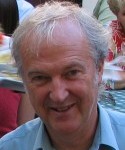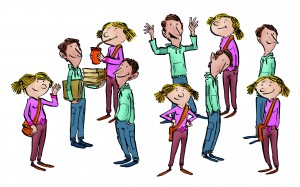Cloning – the facts and the fiction
You’re never alone with a clone!
 This article is by guest-writer Professor John Bryant. He is Professor Emeritus of Exeter University and is a noted writer and speaker. His main science research interests in are in the replication of DNA and in the regulation of gene activity in relation to the cell division cycle.
This article is by guest-writer Professor John Bryant. He is Professor Emeritus of Exeter University and is a noted writer and speaker. His main science research interests in are in the replication of DNA and in the regulation of gene activity in relation to the cell division cycle.
Introduction
What is it about identical twins that makes them so fascinating? We find references to twins in ancient literature and folklore. Quite often, one was depicted as good and one as evil. This was especially true if one was right-handed and one was left-handed (as is often the case with identical twins). The left-handed twin would be regarded as the evil one because there was great suspicion of left-handedness. Indeed, the Latin word for left, sinister, has acquired a meaning in English that implies threatening or evil.
We have not lost that ancient fascination with identical twins (although we don’t think of left-handers as evil anymore; indeed, in cricket, they are highly valued). Some pairs of twins look so alike that it is very difficult indeed to tell them apart and we hear of all sorts of tricks and jokes that twins play on unsuspecting friends (even girl-friends or boy-friends) and perhaps on teachers too. Yet we also know that each one of a pair of twins is a person in their own right, despite their great physical similarities which are based on having almost identical sets of genes (see footnote 1).
In modern fiction it is this second feature, the identical sets of genes, that provides fascinating story lines. For example, in the 1978 film The Boys from Brazil the notorious Dr Joseph Mengele, based in South America, has engaged in cloning Adolf Hitler. Copying a specific person was also the theme of Fay Weldon’s 1989 novel, ‘The Cloning of Joanna May’, in which a man attempts to produce younger versions of his wife. In 1990, Bill Watterson’s brilliant Calvin and Hobbes cartoons had the little boy, Calvin, duplicating himself, urging the ‘doubting Thomases not to let ethics stand in the way of scientific progress’ whilst his toy tiger, Hobbes, expressed grave misgivings. One of the key questions raised by all these, and especially by Fay Weldon, is whether a genetic copy of a person – a genetic clone – would be the same as the person from whom the copy was made. It is a very important question and based on our experience of identical twins, we would say that they probably would not be.
Hello Dolly
Now, it might be supposed that these fictional representations of cloning were based on complete fantasy – examples of science fiction set far in the future – but interestingly when Fay Weldon was tackling this topic, there were already some scientific hints  suggesting that one day, cloning a human would be possible, although the stories themselves went far beyond the bounds of even current, early 21st century possibilities. Nevertheless, how brilliantly prophetic these authors were because in February 1997, scientists at Edinburgh revealed to the media and thus to the public, that the first mammal to be cloned from an adult cell had been born in the previous July. That mammal was a sheep called Dolly and after the announcement, she was revealed ‘in person’ to the hordes of media personnel who turned up at the research station.
suggesting that one day, cloning a human would be possible, although the stories themselves went far beyond the bounds of even current, early 21st century possibilities. Nevertheless, how brilliantly prophetic these authors were because in February 1997, scientists at Edinburgh revealed to the media and thus to the public, that the first mammal to be cloned from an adult cell had been born in the previous July. That mammal was a sheep called Dolly and after the announcement, she was revealed ‘in person’ to the hordes of media personnel who turned up at the research station.
The ‘science bit’
We need to look briefly at how the scientists achieved this, so now follows what in advertising is known as the ‘science bit’. (If you know the science you may move straight on to the next paragraph). During development, different cells develop in different ways in order to play their role in specific tissues in the body. This process is known as differentiation and involves switching on specific genes whilst switching others off. Thus, in the adult body, a differentiated cell expresses only a subset of its total genetic content. However, it does not throw the rest away. The adult cell retains all its genes but most of the genes that are not being used are kept in a ‘locked-down’ state. The scientists wondered whether the whole gene set could be reactivated so that it would direct the development from scratch of a whole mammal. So, they obtained sheeps’ eggs and removed from them their single set of genes. This single set of genes was replaced with the double set from an adult cell. (Remember that in fertilisation, the single set of genes in the egg combines with another single set of genes from the sperm to create a double set; we say that gametes – sex cells – are haploid but all other cells are diploid). Would a cell containing an adult cell’s genes develop in the way the scientists hoped? Well, in a few cases, development of the early embryo went far enough for the embryos to be used to start a pregnancy (in this respect the process resembles IVF but in IVF, the embryos have come from a normal fertilisation event). Most of the pregnancies failed in various ways but one succeeded and thus Dolly was born. [/highlight]
When Dolly was introduced, as the first mammalian clone or genetic copy from an adult cell, to the scientific community (via a paper in the prestigious journal Nature) and to the media via press releases, it generated huge scientific and social interest. Scientifically it was a major breakthrough. Scientists had been trying to clone mammals (mostly mice) since frogs were cloned from adult cells in the 1960s. However, the media ignored the science angle and focussed almost exclusively on the possibility of cloning humans – the fascination with this possibility does not go away. The scientists who cloned Dolly were very clear: this research was not undertaken as a prelude to cloning a human. Nevertheless that was what most of the ensuing debate was about: was it morally right to clone humans?
 Your scientists were so preoccupied with whether or not they could, they didn’t stop to thin
Your scientists were so preoccupied with whether or not they could, they didn’t stop to thin k if they should.
k if they should.
Quote from Steven Spielberg’s 1993 film, Jurassic Park, based on Michael Crichton’s 1990 novel.
Should we or shouldn’t we?
The immediate reactions to Dolly included a frenzy of moral outrage. The Pope immediately condemned cloning outright. The EU quickly enacted legislation to give all persons a right to their own genetic identity. This made me wonder what identical twins thought of this new law but its purpose of course was to make illegal any attempt at reproductive cloning. In the USA, President Bill Clinton asked his advisory committee to report and make recommendations as soon as possible; the committee recommended that reproductive cloning should illegal. But what about in the UK? Here, all procedures that involve handling gametes or embryos outside the body are governed by the Human Fertilisation and Embryology Authority (the HFEA, set up in 1990). The authority pointed out that reproductive cloning would come under their jurisdiction and that in effect it was already illegal: it is not permitted to create identical twins during IVF and since a clone is a genetic twin, legislation already covered it (see footnote 2).
In general, opinion across society and amongst the scientific community is against human cloning. The ethical reasons for this fall into several groups.
• Firstly, the procedure is very risky. Even though techniques have improved, failure rates with all mammals are high and some of those failures include the malformation of embryos / foetuses during pregnancy. Further we do not know whether the cloning procedure itself has risks for the child who will be born. Cloning, unlike ‘normal’ IVF, does not involve the coming together of two sets of genes (which is one of the biological ‘points’ of sex) but does involve significant manipulation of the egg cell and we have no idea of the long-term effects of these procedures. If Dolly is typical, then it is possible that many clones will be vulnerable to early onset of degenerative diseases. Humans would thus be used as experimental subjects for what seem to many people to be very dubious reasons.
• Secondly, the desire to reproduce a particular genotype – to have a child with the set of genes selected by prospective parents – turns the child into a commodity.
• Thirdly, in addition to the specifically biological safety aspects mentioned above, we have no idea of what might be the psychological effects on the cloned person (and of course these will probably differ from person to person). There are likely to be concerns about origins, expectations and perhaps about close physical similarity to the ‘clone donor.’
• Fourthly, there are concerns about family dynamics. The lineage of a clone within a family is strange because his / her genetic parents are actually the parents of the genetic donor who may or may not be related to the carrying mother. The genetic parents of the clone may actually be those who, within the family lineage, appear to be his / her grandparents.
• Finally there are the less definable philosophical objections, for example that cloning offends or even denies human dignity (a term that is very difficult to define) or that, in religious terms, cloned humans would not be spiritual beings. I myself disagree with these particular objections. I cannot see why a particular method of reproduction, even one as un-natural as cloning, would especially offend or deny human dignity. Neither can I see why a clone should not be a spiritual being. Genetic identity to another does not lessen human personhood or spirituality, as we can clearly see with identical twins. Nevertheless I remain opposed to reproductive cloning of humans.
However, there is some support, albeit amongst a minority of the population, for changing the law. In evaluating this ethically, we need to ask why anyone would want to clone a human person. Three reasons have been expressed.
• First, some have wished to re-create themselves or another human being. For example, some sad letters were received by the Roslin Institute (where Dolly was cloned) asking if was possible to re-create a terminally ill child. However, as hinted at already, human persons are much more than their genes and we cannot re-create a particular person just from their DNA.
• Secondly, there are certain cases of infertility and a handful of very rare genetic conditions where the only possibility for a couple to have a child genetically related to one of them would be via a cloning procedure. This strongly consequentialist (see footnote 3) argument in favour of reproductive cloning has been presented several times in the media (see footnote 4). In addition there are lesbian couples who do not wish to involve a male in procreation. The motivation, whether we are thinking of heterosexual or lesbian couples, is not to create a person in any pre-conceived (see footnote 5) image but simply to have a child. Nevertheless, the HFEA, acting under UK law, has consistently forbidden any attempts at reproductive cloning.
• Thirdly, it is said that many of the current ethical objections based on risks are likely to evaporate as cloning techniques improve, making the procedure no more risky than conventional IVF. However, this so far has not turned out to be true for human cloning, even 16 years after the birth of Dolly.
• In respect of possible psychological difficulties and effects on family dynamics, it is suggested that many of these will not arise in a situation in which the motivation is simply to have a child. Furthermore, people cope with much more difficult situations than are posed by being a clone or having one in the family and in any case the fact that the clone is a much-wanted child is likely to eliminate or diminish any of psychological or psycho-social problems.
Thus there are some, very much the minority, biomedical scientists and bioethicists (such as Professor John Harris of Manchester University) who conclude that human reproductive cloning should be permitted. Indeed, some years ago, a bizarre organisation called Clonaid claimed that several cloned babies had been born in the USA (despite legal prohibition of reproductive cloning) but these claims have been shown to be untrue. Nevertheless, it has to be said that there are some biomedical scientists, thankfully very few in number, who might out of sheer arrogance or egoism, attempt to achieve reproductive cloning just because they can, carrying out the procedure in countries where the law does not forbid it.
Conclusion
Scientists are people too and thus share in the moral awareness and responsibility that is one of the marks of humankind. They must ask themselves not just what they can do but also what they should do and should not do. The view of the public is hugely influential. Politicians take heed of the public’s view when they make laws and scientists take heed of the public’s view when they reflect on what to do next.
In the future, society’s views on the issue of human cloning may be different but at the moment, the message to scientists is ‘don’t’ – and most scientists agree with that. One of the reasons it’s important for young people to make the effort to understand this kind of science is so that they can help to make the decisions for the next generation.
Footnotes:
1 You may interested to know that genetically, twins are not quite identical even at the DNA level, as revealed by recent whole genome sequencing studies. This is due to mutations happening after embryo-splitting. Of even greater significance is what are called ‘epigenetic differences’ at birth which are greater in identical twin pairs than in non-identical twin pairs.
2 However, a few years later, Parliament approved an addition to the law making it clear that the prohibition on twinning included reproductive cloning.
3 Consequentialism: a mode of ethical decision-making that evaluates the rightness or wrongness of a course of action by its consequences.
4 Including a TV programme in which Professor Bryant took part: Carlton/West Country TV ‘West Country Witness’, June 1999
5 Excuse the pun!
